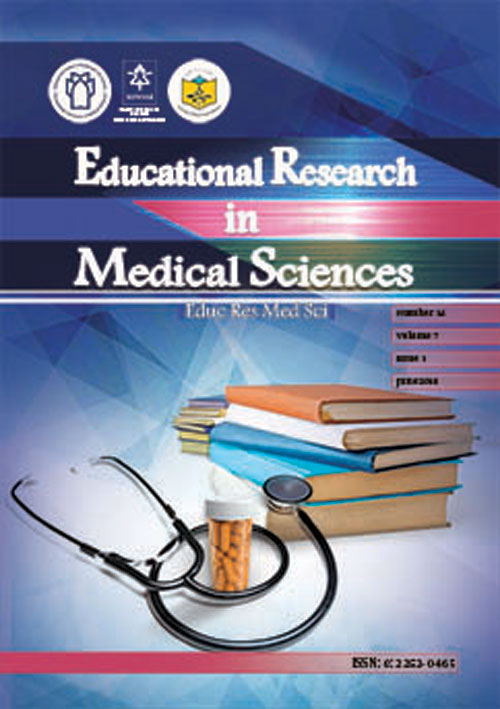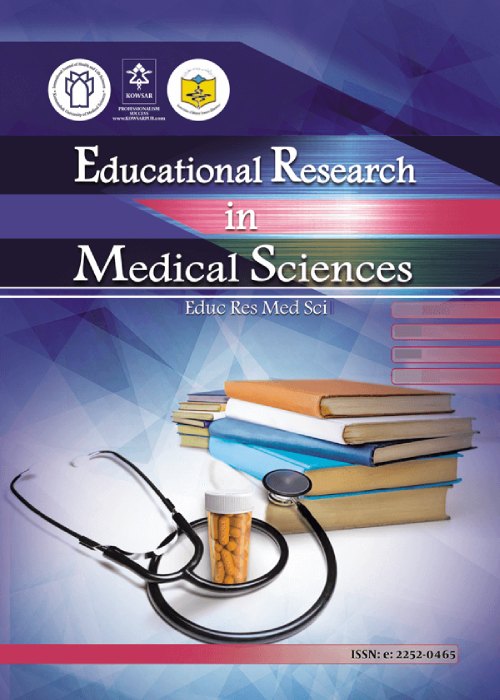فهرست مطالب

Educational Research in Medical Sciences
Volume:7 Issue: 2, Dec 2018
- تاریخ انتشار: 1397/11/02
- تعداد عناوین: 8
-
-
Page 1Context: In order to fulfill its tasks and goals, higher education systems need qualified and competent faculty members. The need for faculty development programs is currently obvious.ObjectivesThe present study aimed to determine the components of faculty development at universities of medical sciences in Iran and across the world, in which, the concepts and dimensions of development, the evolution process and the programs for faculty development of universities of medical sciences were investigated up until now, in Iran and other countries. Data Sources: To obtain the required resources, data were collected through a systematic search in Google Scholar, Medline, Web of Sciences, AIR, ERIC and Springer, ProQuest, and Elsevier databases and from published articles in the Iranian journals available at the SID and IranDoc databases. The articles were selected in accordance with the inclusion criterion of addressing the components of faculty development from different perspectives. Finally, 40 articles carried out in Iran and some other countries and published between 1966 and 2017 were found.ResultsIn this study, four dimensions of individual, professional, educational, and organizational development were identified. However, most studies were concerned with educational development and most of the given theories were about training faculty members via scientific workshops and seminars. Furthermore, evaluations were often conducted in the same vein, and in most studies, an organizational perspective was adopted and the focus was on organizational goals.ConclusionsConsidering that the requirements and conditions of faculty members vary across different universities, disciplines and conditions, the development programs should be designed to target specific subgroups and cover a wide range of skills, not just education.Keywords: Faculty Members, Development, Universities, Medical
-
Page 2Context: The present study used a strategic approach to develop a conceptual framework for evaluating the curriculum effectiveness, which appears not to be limited to the internal dimension as far as the strategic approach is concerned as a comprehensive, environment-based and future-oriented method including both external and institutional dimensions. Evidence Acquisition: Given that the available information about the effectiveness of medical education curriculum based on a strategic approach is institutionally qualitative, multidimensional and consequential, exploring, extracting and analyzing the related data requires using a qualitative model for dealing with the diversity of resources and information. A review of literature suggested that the cyclical process of analysis is a qualitative research method with the required characteristics consisting of the following phases: (1) Data collection process, (2) data reduction, (3) data organization and analysis, and (4) conclusion (interpretation and conclusion). Triangulation was used to validate the findings of the research method.ResultsCertain components of the effectiveness evaluation of medical education curriculum based on a strategic approach include achieving the internal goals of curriculum, satisfying the requirements of the internal environment through curriculum implementation, developing students’ knowledge, attitude and skills, the internal coherence and consistency of the curriculum and the internal quality of the curriculum. These components also include fulfilling the goals, social acceptance of the curriculum, significant roles in social development, national self-sufficiency, proper performance and the education system reforms, improving the external image, and the strategic success of medical education curriculum.ConclusionsThe results of these comprehensive strategies include knowledge and skill adjustment, professional responsibility, spirit of accepting the change, flexibility, adaptability to the varying environment, optimal use of resources, and receiving feedbacks on the effectiveness of the implemented programs to modify or clarify the goals or strategic selections and decisions.Keywords: Curriculum, Curriculum Evaluation, Curriculum Effectiveness, Strategic Approach, Medical Education
-
Page 3BackgroundNursing education is an education system that encompasses cognitive, affective, and psychomotor learning fields. The main goal in this system is to graduate nurses who can integrate theory and application, who think critically in the learning process, and who have gained effective problem solving skills. For this reason, it is important to use novel approaches that improve occupational skill in nursing education.ObjectivesThe study was performed in order to determine the effect of the high-fidelity simulation method on the critical thinking and problem solving skills of nursing students.MethodsThe study used a randomized, controlled, pre-test post-test experimental research model, and enrolled 60 students. Data was collected using a student identification form, an occupational skill application checklist, the California critical thinking inclination scale and the problem solving inventory. Mean values, standard deviations, the Student t-test, the paired sample t-test and the chi-squared test were used in data evaluation.ResultsIn comparisons within and among groups between the pre-test and post-test applications no statistically significant differences were found between the California critical thinking inclination scale and Problem Solving Inventory mean scores.ConclusionsIn the study, the simulation method was found not to be superior in improving the problem solving and critical thinking abilities of students compared to the traditional education method. Performing similar studies with a larger sample size comparing different education methods is recommended.Keywords: Critical Thinking, Nursing Education, Nursing Student, Problem Solving, Simulation
-
Page 4BackgroundMotivation is the key factor for success and welfare. It is a pre-requisite in the process of teaching-learning and a factor in academic growth.ObjectivesThe purpose of the present research is to convey the experiences of medical sciences professors on the educational motivations of students in universities of medical sciences.MethodsThe research was carried out in 2017 in Iran. A purposive sampling method was used and continued until theoretical saturation of data. Sixteen professors and Ph.D. students with teaching experience in medical schools participated. Data was collected with in-depth and semi-structured interviews. All the participants were asked at least two of the following open questions: “What is your understanding of the motivation or lack of motivation for student learning?”, “Which factors are effective in motivation learning?”, and “Which strategies have you used to promote student motivation in learning?” The conventional content analysis approach was used for data analysis. Validity, acceptance, confirmation and transmission criteria were used for correctness and solidity of data.ResultsBy analyzing the transcriptions of interviews, the four main themes of educational motivation for students were determined as “communication between teacher and student”, “characteristic traits of trainer and leaner”, “Importance of motivation in the teaching and learning process” and “educational skills”.ConclusionsBased on the research findings, professors expressed that the students’ educational motivations were not satisfactory and educational and training programs in universities needed improvement. They also emphasized on the teachers’ abilities and training skills in sciences for effective communication between teacher and student.Keywords: Academic Motivation, Amotivation, Perceptions, University Students, University Professors, Content Analysis
-
Page 5BackgroundEvaluating the self-perceived confidence of students in their abilities to provide orthodontic services is crucial to measuring the effectiveness of the orthodontic curriculum.ObjectivesThe purpose of this study was to investigate the relationship between general self-efficacy (GSE) in dental students and self-perceived confidence in performing orthodontic clinical skills.MethodsA total of 100 dental students in their final-year at Shiraz University of Medical Sciences participated in the study in February 2017. They responded to a multiple-choice questionnaire consisting of two parts. The first part evaluated the students’ self-perceived confidence in performing orthodontic clinical skills and the second part evaluated the students’ GSE. The correlation between the two parameters was evaluated using the Spearman correlation test with an alpha level set at 0.05.ResultsMore than 20% of the students reported being “not yet confident” in 8 out of the 18 skills evaluated. There was a medium correlation between the students’ confidence in performing clinical skills and their GSE. There was no correlation between the students’ grades in theoretical courses and their GSE scores (P > 0.05). The students’ confidence in all aspects of clinical skills, however, was correlated with their grades.ConclusionsThe students’ self-perceived confidence in performing orthodontic clinical skills is moderately correlated with their GSE; other factors such as exposure to orthodontic cases, and teaching methods seem to play a more influential part in their confidence.Keywords: Orthodontics, Clinical Skills, Dental Education, Self-Efficacy, Self-Confidence
-
Page 6BackgroundKnowledge of anatomy is the basis of medicine and clinical practices. This study aimed to determine factors affecting anatomy learning from the viewpoint of students at Kermanshah University of Medical Sciences.MethodsThis cross-sectional study enrolled all students at basic sciences stage at the School of Medicine at Kermanshah University of Medical Sciences in 2016 and 2017. A questionnaire was delivered in classrooms by the researchers with the permission of the teachers. Data was analyzed in the SPSS-16 software, employing the Mann-Whitney and Kruskal-Wallis tests.ResultsOut of 300 questionnaires, 179 were returned, 71 from male students (39.7%) and 108 from female students (60.3%); 116 (64.8%) in the third semester, 31 (17.3%) in the fourth, and 32 (17.9%) in the physiopathology level. Significant differences were found between the viewpoints of male and female students on the following variables: Use of animation, use of moulages, questions based on references, frequent quizzes, classified tests during the term, and the teachers’ patience, indicating the ‘clear expression of teachers’ with a mean of 4.7 ± 0.47 as the main effective factor. There were significant differences between the mean scores for ‘design of questions based on the sources’ (P < 0.05) and also between the views of physiopathology students and third-year students (P < 0.05).ConclusionsLecture-based education without proper audio-visual aids lacks popularity among students, resulting in a waste of time and low levels of student learning. Mentioning the clinical aspects and engaging students in clinical issues to improve learning is paramount.Keywords: Anatomy Learning, Medical Students, Kermanshah
-
Page 7BackgroundWe investigated three specific researchpurposes(1) To assess the performance of tutors in guiding problem-based learning groups after participating in the tutor training program (TTP); (2) to examine the differences between tutors’ performance in related factors, including the tutors’ gender and education level; (3) to determine the tutors’ reaction to and learning from TTP.MethodsThis mixed method, concurrent triangulation study was carried out at Tehran University of Medical Sciences, School of Medicine in 2015. The participants included 22 students of medicine as tutor and 240 newly admitted students as tutee. After training, each tutor was assigned to a group of 10 members (a total of 22 groups) (n = 240) at a PBL session. Based on the Kirkpatrick's model, the tutors’ reaction to and learning from the TTP were evaluated using a peer evaluation form. Furthermore, utilizing the field note record form, their performance was recorded by an expert external observer.ResultsThere was no evidence of difference in tutors’ performance between men and women. The median was 13.37 (13.16 - 13.90) for men and 13.40 (12.37 - 13.48) for women, P = 0.89. We found no difference in tutors’ performance based on the level of education using the Kruskal- Wallis test (χ2 = 1.84, DF = 2, P = 0.39). Analysis of the field notes showed 4 main themes.ConclusionsThe performance of men is as good as women in tutoring. Furthermore, junior students perform the same as senior students. Four main themes of tutors’ performance in PBL session were “helping to learn how to apply basic science”, “deep learning enhancement”, “group dynamics creation” and “interest in the field of education”.Keywords: Active Learning, Experiential Learning, Problem-Based Learning


